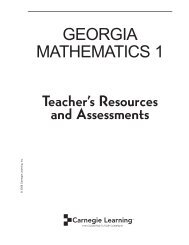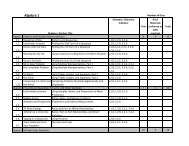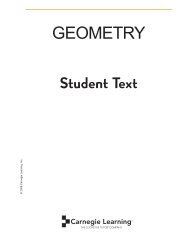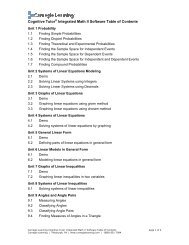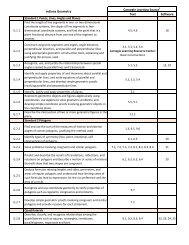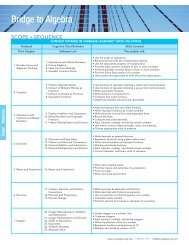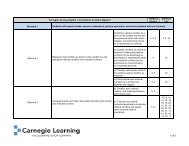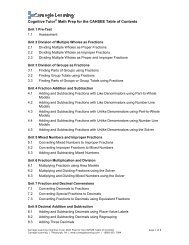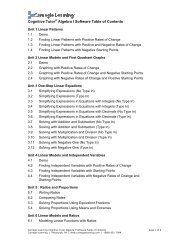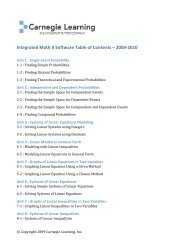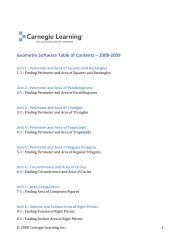LEARNING BY DOING MATHEMATICS - Carnegie Learning
LEARNING BY DOING MATHEMATICS - Carnegie Learning
LEARNING BY DOING MATHEMATICS - Carnegie Learning
Create successful ePaper yourself
Turn your PDF publications into a flip-book with our unique Google optimized e-Paper software.
STUDENT<br />
TEXTBOOK SET<br />
Each student receives a textbook set<br />
that contains the following three books.<br />
Student Text<br />
The Student Text is a consumable<br />
textbook designed for students to take<br />
notes and work problems directly in<br />
each lesson. Each lesson contains<br />
objectives, key terms, and problems that<br />
help the students to discover and<br />
master mathematical concepts.<br />
Student Assignments<br />
The Student Assignments book contains<br />
one assignment per lesson and skills<br />
practice activities. It is designed to move<br />
with the student from classroom to<br />
home to lab time so that students can<br />
repeatedly practice the skills taught<br />
in the lesson.<br />
Homework Helper<br />
The Homework Helper book is designed<br />
to help parents and care givers be more<br />
informed about the concepts being<br />
covered in the student’s math course.<br />
Students are encouraged to keep the<br />
Homework Helper at home. It contains<br />
one activity per lesson including<br />
examples of the skills taught in the<br />
lesson and several practice problems.<br />
Answers to the practice problems are<br />
provided in the back of the Homework<br />
Helper book.<br />
What Makes <strong>Carnegie</strong> <strong>Learning</strong> Student Texts Engaging<br />
<strong>Learning</strong> By Doing ® Principals<br />
<strong>Carnegie</strong> <strong>Learning</strong> believes that students develop math<br />
understanding and skills by taking an active role and<br />
responsibility for their own learning. With <strong>Carnegie</strong> <strong>Learning</strong><br />
textbooks students become engaged in solving contextual<br />
math problems that strengthen their conceptual<br />
understanding of math topics. Rather than encouraging<br />
students to memorize procedures, we provide them<br />
opportunities to think and work together in small groups.<br />
Mathematical Discourse<br />
Throughout the student text icons prompt different forms of<br />
student communication. These icons may instruct students to<br />
work independently, work with groups, or share ideas with the<br />
class. Encouraging mathematical discourse provides<br />
opportunities for students to explain their thoughts and<br />
processes for solving math problems.<br />
Real-World Context<br />
Students work with their peers to solve real-world problem<br />
situations like using percents for leaving a tip in a restaurant<br />
or using a graph of an equation to determine the number of<br />
days it will take to build miles of highway. They become more<br />
engaged in learning mathematics when they see how it plays<br />
a significant role in everyday life.<br />
Think for<br />
Yourself<br />
Work With<br />
a Group<br />
Share With<br />
the Class




